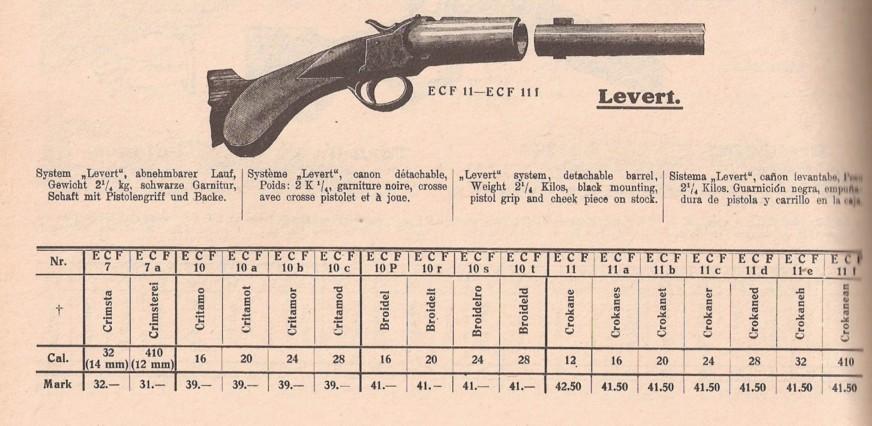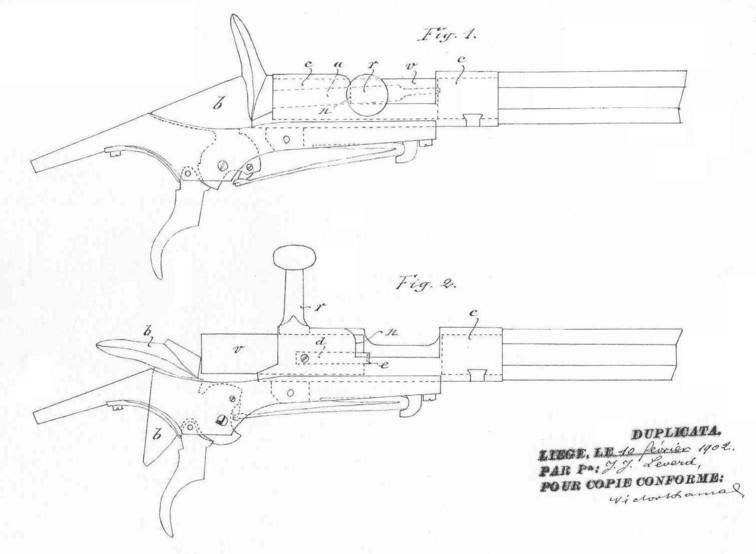Some of the most beautiful work of this craftsman, and many others, are in this book “Liège Gunmakers through their Work. 1800 - 1950”.
For more detail see: LIEGE GUNMAKERS
LEVERD Jean Jacques
Undoubtedly a funny good of machine whose identification would undoubtedly have taken “a certain time” if the copy of the catalogue n° 53 of 1912 of house J.B. Rongé Fils had not fallen between our hands. On page 46 indeed appears there this funny of “thingummy” due to Jean-Jacques Leverd, who existed in several versions, would be this already only for the stock: stock pistol or English, with or without cheek. All the gauges were available, of the 12 to the 12 mm while passing by the 16, 20, 24, 28, 32 and14 mm. This specimen is in two parts, but there were also versions in three parts (with broken barrel) and in four parts, with broken barrel and stock.
The system is directly derived from that of a bayonet with casing. The barrel, provided with two nipples of different size, is embedded in the breech and is blocked after a small rotary movement. The barrel is released after having supported on the nozzle of a spring of a little more than one half-circle which blocks the small lower nipple. The operation is very fast and must be done after the shooting of each cartridge.
Useless to say that this type of weapon had certainly to be more often found between the hands of a poacher than of an honest hunter. The Rongé catalogue does not mention alas the prices, but there is not a doubt that he was not to be very high.
On the breech the word CHAMPION is reproduced, but it does not have certainly anything to see with mark THE CHAMPION deposited by Auguste Francotte, nor with that of THE CHAMPION off the WORLD of J.B. Rongé.
One does not know in any case large-thing of this Jean-Jacques Leverd: “Who’s who arms manufacture of Liège” teaches us that it was a manufacturer of weapons with Cheratte between 1893 and 1902. It deposited two patents concerning of the modifications to simple, dismountable barrel rifles (with Counet?) and another, in 1902 (?), bearing on a modification with the Flobert rifles.
Our specialist of punches identified as follows:
Spangled ELG in a crowned oval: acceptance post 1893;
PV surmounted of a stylized lion: test with the powder without smoke post 1898;
EL into cursive: provisional test post 1852;
B spangled being able to be the countermark of Charles Roland, credit of 1927 to 1959;
Coupled AH and spangled: countermark of the controller post 1877;
20-70 in an omega lying: gauge nominal and length of casing post 1924;
0kg743: weight of the barrel which can draw from the cartridges with powder without smoke (weapons smooth) except for the gram, of use of 1924 to our days;
Choke 15.9 gun choke, gauges to22 cm of the breech, of use of 1924 to 1968;
Appear also the letter O annals of 1936, which thus gives the year of manufacture of the machine.
There is finally D crowned which could be the mark of Delcour-Dupont Jean (manufacturer of barrels of rifles) deposited the 06.06.21.
GP (with the invaluable assistance of GG)


Other arms manufacturers did not hesitate to put this at the very least particular rifle in their catalogue.
Thus, on page 40 of a catalogue of Joseph Saive, obviously not dated, one finds the standard machine 82, this time qualified of SWISS RIFLE marks “Champion”, which corresponds besides completely to the part photographed.
It should be noted that there exists only in the simplest version of English stick and without cheek, and in one gauge, the 16.


The Alpha catalogue of 1911 presents also this rifle at the foot of the page 298.
Let us note the other orthography (Levert instead of Leverd).
It is about a stick pistol to cheek, and all the calibres are available, of the 12 to the 410, for a variable price between 31 and 42,50 marks.
A Leclercq rifle with key snake was sold with the same price…


Patent LEVERD of 1902 on the modification of the Flobert rifles
